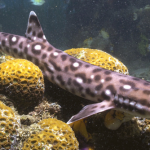Inspired by the Are Headlines Hogwash? series at Dr. Carin Bondar’s wonderful blog, the editors at DSN (i.e. Kevin and I) have initiated a news series called Bull Patrol! Our goal is to call out the media for the getting carried away with headlines and reports, not doing their homework, making a mockery of colleagues’ work, and generally confusing the public.
This week’s rant centers on a flurry of media, e.g. CBC, on the “discovery” of “new” species from underwater canyon called the Gully, the Flemish Cap and the Orphan Knoll in the North Atlantic.
Dr. M: The issue here is that many of these purported new species are actually described. Indeed, a well-known expert on some of these organisms stated in an email to us that at least two of these species are known to science. This is not the first time I have seen press releases immediately after an expedition exclaiming the findings of “new species”. The problem is, and I am sure KZ will articulate this well below, is that describing an animal as a bonafide new species requires many years of work. I am leery of any press release or news article about a new species at the end of research cruise. I would also be leery of any scientific claim immediately following field work without vetting through the peer-reviewed publication process. Describing a new species is no different. Note to scientists: please be cautious about statements concerning new species. Often the press might not understand nor want to understand the difference between
- This is the first time we have ever seen this species at this specific place!
- Hey look! This is an unusual species only recently known to science and this represents an increase in our knowledge!
- Hey look at the biodiversity of this area!
- Holy Shit!!! This is a totally new species and I know that exactly because I spent countless years in the lab running genetics tests, looking over dusty old papers on all the species that look similar to this one, countless hours over a microscope looking at all the wee little bits that define this species, doing everything again to make sure I didn’t screw anything up the first time, writing up the paper, suffering through peer review, and years later actually publishing a new species name!
I am worried that when we claim to the media or the media interprets our statements of new species findings that we devalue taxonomists who actually do #4.
Kevin Z: While discovery of new species can be accelerated by a focused attention at the end of a research cruise, it often takes quite a long time between study and publication of the species names. Let me give you an example from my own work. In 2009, I published with my colleague a new species description of a shrimp from a hydrothermal vent habitat. This discovery really starts way back in 2005 though. I’ll spare you the details, they are are in the post I linked to above for those who are interested. But the short story is determined to be new species in Summer 2006, described by November 2006, Paper written and submitted by January 2007… crickets…. accepted with revision September 2007, revision submitted November 2007…. crickets… Final acceptance April 2008… crickets…. more crickets… sound of my telomeres shortening… published online March 2009, available in print edition April/May 2009. My point is that scientists don’t know if something is new fresh off the cruise. We were already to go to press with a what we thought was a new worm species once. Turns out after doing some genetics and scouring the literature, Japanese researchers described it 2 years before from a totally different location. Another example is the press releases of new stauromedusae species from vent sites at the East Pacific Rise a couple years ago. That was made by geologists on cruise while they were still out at sea. As someone who saw the very first vent stauromedusa (an upside down, stalked jellyfish) get collected in 2003, I could tell these were the same, the only difference being orange in color. Well it turns out they were orange because they were packed with gonad ready to spawn.
Dr. M has a good point that should be standard procedure for scientists coming off an expedition talking to the press. There are two interesting discussions though coming off from this in my opinion. The first being where is the line between relaying the excitement of discovery and not misleading the press and public. This is a tough call and certainly open to debate. But after a million-dollar taxpayer-funded cruise, there better something cool to talk talk about right? Something better be mind-blowing right? I’m sure there will be great science from every expedition in some form, but we might not know the interesting tidbits until well-after the cruise, or maybe not until there is a follow-up cruise.
The second being what is the appropriate message for the press to get out there. It is not strange nor unusual to find new species in the deep-sea. According to a PLoS collection on marine biodiversity that was just released today, for every species known 4 are undiscovered. “NEW SPECIES DISCOVERED” is not an interesting headline or topic, it tells no story and does not engage the reader or make the reader think. Being able to quantify what we do and do not know is a better story and instills a better sense of appreciation for the work of scientists. Sentences like “Many of the species collected are so new to science that they have yet to be named” are just plain retarded – a species being new to science by definition means we have not yet named them – and do not do any justice to the work of scientists in the field and the taxonomists who be studying whether or not these guys are, after all, new to science (and will appropriately append names to them).






Gentlemen, if this is the worst thing “The Media” has done to you and your science, you’re really leading charmed lives.
The driver of this coverage was some beautiful photos and the desire of a few websites to generate some clicks with them. (worked for me, dude!) Their intentions were benign, and I’ll argue, their crime was inconsequential. Is it really such a huge hairy deal that the unsophisticated “journalist” said “new species” instead of “cool species?”
Rather than cautioning the scientists to be careful about what they say, I’d counsel them to gush and emote and get a bit crazy and just share their enthusiasm as if they were talking to little kids. Because when a scientist is being careful, they tend to pile on polysyllabic, hyper-specific, CYA gobbledy gook that actually makes it MORE likely that the poor schlub who’s writing captions for the website at 3 a.m. will misinterpret the import of what the pictures are about. (Some of these people are in fact biology PhDs who couldn’t find honest work, but you can’t count on that.)
Just say “here’s a cool little octopus,” not “here’s megacarpallocephalaodimbus newtonia expressing kinase 41AF35/3 in his blah blah apparatus…” If the pictures are that good, nobody gives a rip whether the species is “new” or not — they’re just cool!
The next time your favorite submarine comes up for funding, it’s coverage like this that helps you make your case. Burying your findings in arcane jargon or intimidating “the media” about their alleged mistakes won’t help your cause.
Interesting stuff guys and I find myself agreeing with all three of you but probably leaning with Dr. M and Kevin Z. It is all too rare to see the taxonomists getting the cool sexy press releases they deserve. Without them all you have is a bunch of wierd crap in your trawl- no real info.
I agree with “lb8s” that it isn’t the media’s fault though (and I think Dr. M was directing his comments towards scientists). Surely this could be solved with a few key phrases in press releases from newly returned expeditions, such as “appear to be new..” or the more probable “but its too wierd to know for sure”? Journalists will undersatnd these caveat words but still be able to hype it up and then when the actual description comes out put out another crazy press release. Boom: maximum exposure!
Guys, its really not fair to place the blame on scientists. You can tell the media one thing and they print another. That’s just the way it is. A recent expedition to West Coast Sanctuaries reported four species not previously known from sanctuary waters. What did the press report? Four new species!
My point exactly, Peter. Syntax like “not previously known” translates to NEW in plain English. Say it plainly yourself so that the journalists don’t have to guess. When they guess, they’ll get it wrong.
Syntax can often be improved, but I disagree that scientists are the root of the problem. I also disagree that scientists should do the job of the journalist. Captions at 3am? Whose fault is that?
I have to agree with klb8s on this. Not that I like the mangling of science by the press, far from it (see for example http://is.gd/e90kV), but in the grand scheme of things, exactly how new a new species is isn’t the point we should be arguing. We should just be happy that they want to cover photos of slimy spineless things at all and use the opportunity to convey as much enthusiasm as we can (and maybe a little educational message too)
Now, if in an attempt to be “balanced” they give equal time to BS “alternate theories” to climate change or evolution, THAT we should complain about. Or if they lose the essence of the study by changing emphasis to meet editorial goals (if it bleeds it leads etc.), misquoting or just botching it. That stuff we have to fight if and when it occurs, because it flat out misrepresents what we’re all about.
Potential bull patrol material?
http://www.gesundheit.ca/?gclid=CKuA-u2sr6MCFREslAod8jLh2g
Next time you sneeze reach for “gesundheit”. This is gold!